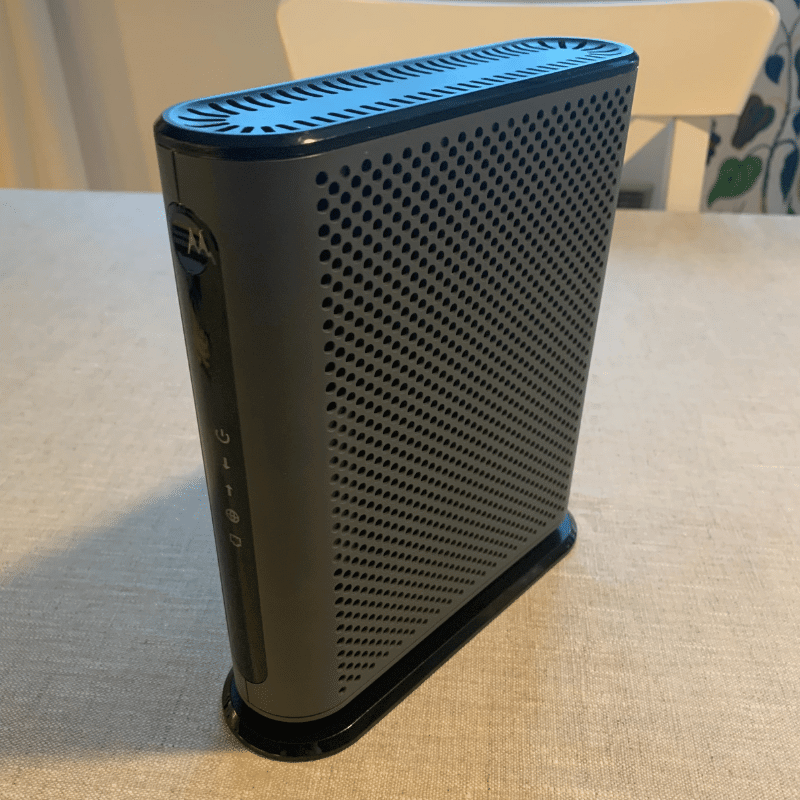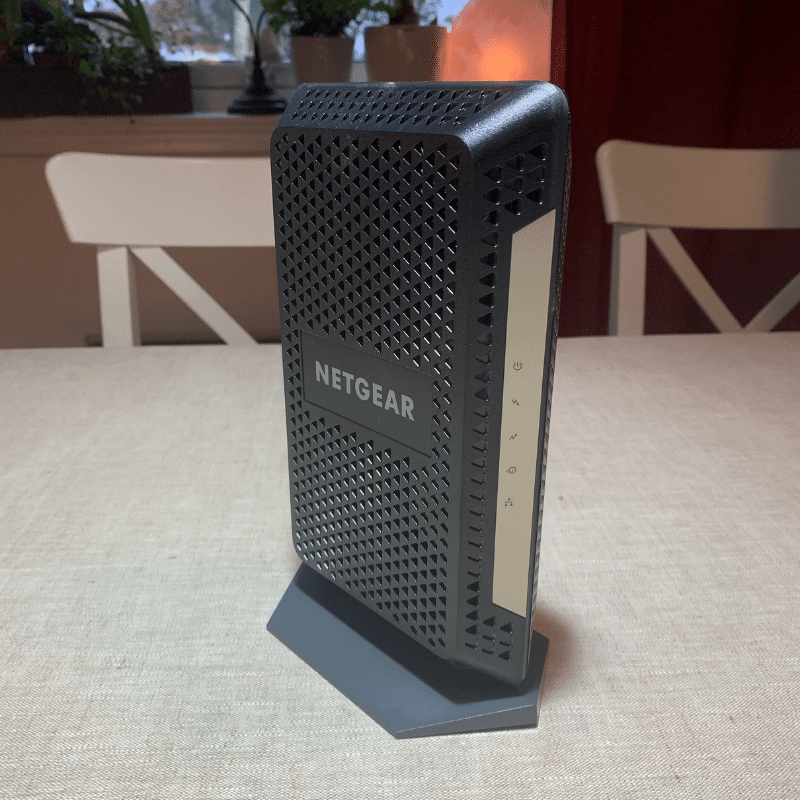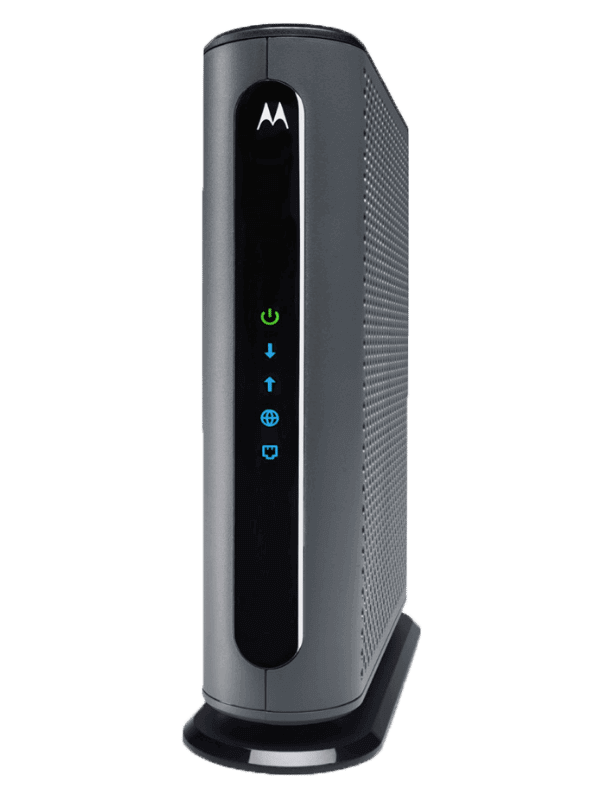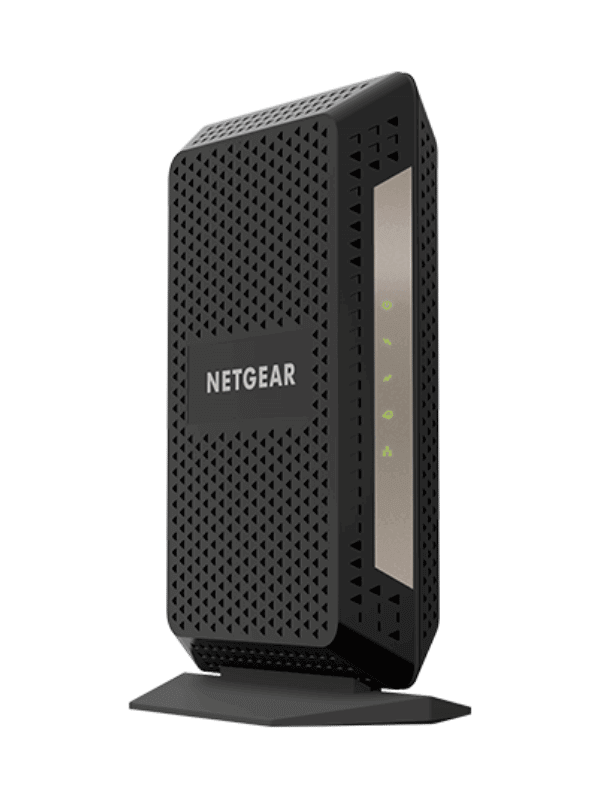The main difference between the Motorola MB8600 and Netgear CM1000 is the Internet speeds they can handle. The MB8600 supports plans up to 2000 Mbps, and the CM1000 supports up to 1000 Mbps plans.
The MB8600 is also less expensive, but the CM1000 is compatible with more ISPs. So, if you have a cable Internet plan faster than 1000 Mbps and want to future-proof your home network the best, the MB8600 is your best option.
And since it costs less than the CM1000, it is the better choice if your Internet plan is slower than 1000 Mbps– unless it isn’t compatible with your ISP.
Motorola MB8600
Overall Winner
- Performance – Winner
- Compatibility – Loser
- Design – Draw
- Setup – Draw
- Value for Money – Winner
Netgear CM1000
More Compatible
- Performance – Loser
- Compatibility – Winner
- Design – Draw
- Setup – Draw
- Value for Money – Loser
I’m Jon, a home networking enthusiast, and I’ve tested several modems with my home Internet.
I made this guide to help you figure out if the MB8600 or CM1000 is best for you.
So, let’s dive into the pros, cons, features, and major differences between each option.
Key Takeaways
- The Motorola MB8600 works with faster plans, up to 2,000 Mbps (2 Gbps), and is more affordable.
- The Netgear CM1000 works with plans as fast as 1,000 Mbps (1 Gbps) and is compatible with more ISPs.
- The MB8600 uses port bonding to work with Internet speeds faster than 1000 Mbps. Port bonding requires two IP addresses and a compatible router.
Motorola MB8600 & CM1000 Compared
Here is a brief comparison of the critical specifications of the MB8600 and CM1000.
| Specs | MB8600 | CM1000 |
| Recommended for | Plans up to 2000 Mbps | Plans up to 1000 Mbps |
| Tops Speeds | 2000 Mbps (2 Gbps) | 1000 Mbps (1 Gbps) |
| Compatible ISP’s | Armstrong, Breezeline Comcast Xfinity, Charter Spectrum, Cox, Mediacom, Midco, Suddenlink, WOW, Sparklight | Armstrong, Breezeline, Comcast Xfinity, Charter Spectrum, Cox, GCI, Grande, Mediacom, Midco, Suddenlink, WOW, Sparklight, Optimum, RCN, Wave |
| Not supported ISPs | Astound Broadband (RCN, Grande, or Wave), Optimum | N/A |
| Ports | 1 open and 3 masked 1G Ethernet LAN & 1 × Coax | 1 Gigabit Ethernet port & 1 Coax port |
| Future proof | Most future-proof | Reasonably future-proof |
| Ethernet aggregation | Yes, by using two 1 Gbps Ethernet ports | No |
| DOCSIS | 3.1 | 3.1 |
| Dimensions | 7.25 × 2.25 × 7.88 inches | 8.8 x 3.5 x 5.9 inches |
| Weight | 18.4 ounces | 15.2 ounces |
| Gaming | Very Good | Good |
| Price | $$ | $$$ |
| Warranty | 2 years | 1 year |
| Winner | Loser |
First Thoughts
For most homes, the Motorola MB8600 modem is the better choice. It supports faster Internet plans (up to 2000 Mbps) and is more affordable. However, if the MB8600 isn’t compatible with your ISP, the CM1000 is a better option.
The MB8600 supports Internet plans up to 1000 Mbps with a single Ethernet connection and 1000 Mbps to 2000 Mbps with port bonding or Ethernet aggregation. Port bonding combines two data streams into one. [1]
The MB8600 is best for people with Internet plans over 1000 Mbps or who want to prepare for future speed increases from their ISP.
On the other hand, the Netgear CM1000 is slower, supporting speeds up to 1000 Mbps. Unlike the MB8600, it does not have port bonding. But if your ISP only offers plans slower than 1000 Mbps, this might not be a deal breaker for you.
But since the CM1000 is more expensive than the MB8600, it makes more sense to get the lower-cost MB8600 to better future-proof your home network. Unless you have one of the few ISPs that aren’t compatible with the MB8600.
Motorola MB8600 Review

The Motorola MB8600 is a fast and future-proof modem; it supports 2000 Mbps and is a DOCSIS 3.1 unit. It has two 1Gbps (1000 Mbps) ethernet ports, which you can combine with Ethernet aggregation into a single data stream.
The MB8600 setup is fast and easy, is very reliable, and has fantastic build quality. It is more affordable than the Netgear CM1000 too. So, it’s a good option if you want to save some money and have compatibility with faster plans.
It is compatible with many Internet providers– but not all. The known providers it has issues with are Astound (RCN, Grande, and Wave) and Optimum, unlike the CM1000.
Overall, the MB8600 is a better option than the CM1000– even if you have a plan slower than 1000 Mbps. It will future-proof your network and save you money, assuming you use it with an approved ISP.
Read our complete review of the Motorola MB8600 for more information on this modem.
Netgear CM1000 Review

The Netgear CM1000 is also a DOCSIS 3.1 modem that can support Internet plans up to 1000 Mbps. Unlike the MB8600, it does not have an additional Ethernet port for Ethernet aggregation/port bonding.
Still, it is reasonably future-proof and good for Internet plans of 1000 Mbps or slower, which isn’t a lot considering it is DOCSIS 3.1. If/when your ISP starts providing faster plans, you will have to upgrade this modem to access it.
One area the Netgear CM1000 excels is ISP compatibility– it is the most approved cable modem on the market.
But it is expensive– even more than modems that have port bonding and can support 2000 Mbps plans. Besides the MB8600, the Arris Surfboard SB8200 is a better choice– which also works with virtually every ISP.
Read more about the SB8200 here.
That said, the Netgear CM1000 is far from being a “bad modem.” It has decent performance for plans slower than 1000 Mbps, a good design, a mostly smooth setup, and is sure to work with your ISP.
Read our complete review of the Netgear CM1000 modem for more information.
Performance – Winner MB8600
If it is not apparent by now, the Motorola MB8600 has superior performance over the CM1000 since it can support speeds up to 2 Gbps with port bonding and 1 Gbps with a single Ethernet connection.
Conversely, the Netgear CM1000 can only support plans up to 1 Gbps.
That said, using port bonding (Ethernet aggregation) is more complex than using a single connection. And most ISPs don’t offer plans faster than 1 Gbps yet anyway (although I personally have a 1.2 Gbps plan).
So, if you have an Internet plan much slower than 1000 Mbps, you might think the Netgear CM1000 is a better choice. In that case, I would tell you to look at and weigh other factors– mainly price.
The Motorola MB8600 has better performance, supports faster Internet plans, and is less expensive.
Both the MB8600 and CM1000 are DOCSIS 3.1 modems, the newest standard for the cable transmission of Internet Protocol (IP) data services.
It is faster, more secure, uses less power, and has lower latency than DOCSIS 3.0 (the previous standard).
Nearly all ISPs use DOCSIS 3.1, but a few small regional ones may still be on DOCSIS 3.0. In that case, both of these modems will work since they are backward compatible.
Read our complete guide to learn more about DOCSIS 3.0 and 3.1.
Compatibility – Winner CM1000
The Netgear CM1000 is approved by all major ISPs. On the other hand, the Motorola MB8600 works with most of them– there are just a few it doesn’t work with.
“Compatible” and “approved” means the ISP or a third party tested and verified the modem work on the network. But sometimes, a modem isn’t on an approved list because it hasn’t been tested yet.
Here are the ISPs the MB8600 is not compatible with:
- Astound Broadband (including RCN, Grande, and Wave)
- Optimum
We haven’t heard of any ISPs with cable Internet that the CM1000 isn’t approved for.
MB8600 Supported ISPs
The Motorola MB8600 is approved for the following ISPs:
- Armstrong
- Atlantic Broadband
- Comcast Xfinity
- Charter Spectrum
- Cox
- Mediacom
- Midco
- Suddenlink
- WOW
- Sparklight
The MB8600 may be compatible with other ISPs. This is not an extensive list. So, call your ISP and ask them if it works if your ISP isn’t listed.
CM1000 Supported ISPs
The Netgear CM1000 supports the following ISPs:
- Armstrong
- Atlantic Broadband
- Comcast Xfinity
- Charter Spectrum
- Cox
- GCI
- Grande
- Mediacom
- Midco
- Suddenlink
- WOW
- Sparklight
- Optimum
- RCN
- Wave
If your ISP isn’t listed here, that doesn’t mean it isn’t compatible with the CM1000. Call your ISP to confirm.
Design – Draw
The Netgear CM1000 and Motorola MB8600 both have a sleek and modern design. They are slim, and tall, and take up minimal shelf or desk space.
They each feature black and dark gray color schemes. However, they look discernably different– which comes down to personal preference on which looks better.
The MB8600 features rounded edges with cooling vents on the left and right, with a narrow stand. On the other hand, the Netgear CM1000 has sharp corners and angled planes on the top and bottom, with a slightly wider stand.
Both modems have status LED lights arranged vertically along the front to indicate power, downstream, upstream, Ethernet, and the Internet.
On the backside, the Motorola MB8600 has one open and three masked 1G Ethernet connections (for port bonding), one coax connection, and reset button, and a power port.
The CM1000 has one Ethernet connection, one coax connection, a power plug, and a reset button.
Setup – Draw
Both the Netgear CM1000 and the Motorola MB8600 are fast and easy to set up. Both took us under five minutes to get up and running. They each come with simple instructions but are mostly “plug-and-play.”
Here are the simple instructions to get them up and running:
- Plug the coax cable from your ISP into the rear of the modem.
- Connect the modem and router (or a computer) together with an Ethernet cable (each modem includes one).
- Plug in the modem’s (and router’s) power cables.
- Load any web browser on your computer. It should automatically load your ISP’s self-activation page. If not, call your ISP and tell them your modem’s MAC address (located on the back or bottom of the modem) to activate it.
To access the CM1000 and MB8600’s modem page, you can type http://192.168.100.1/ into any web browser.
The modem page allows you to view status, logs, and more network information. [2]
If you like to view more about the setup of each modem before you buy one, you can look at the MB8600 and CM1000’s setup guides first.
For more help getting your modem set up, see our general modem guide here.
Value – Winner MB8600
I may sound like a broken record at this point, but since the Motorola MB8600 supports up to 2000 Mbps with port bonding and is less expensive than the Netgear, the MB8600 is more valuable.
Even though most ISPs top out their plans at 1000 Mbps, many will offer faster cable Internet speeds soon. Case in point, I currently get 1200 Mbps from my ISP.
So, if you’re comparing the CM1000 to the MB8600, you might as well save money by getting the MB8600 while better future-proofing your home network for speed increases.
However, if you have one of the few ISPs that aren’t compatible with the MB8600 (Astound Broadband, RCN, Grande, Wave, and Optimum), then the CM1000 is the better choice between the two.
FAQs
Here are some common questions about the Motorola MB8600 and the Netgear CM1000.
What’s the main difference between the Netgear CM1000 and the Motorola MB8600?
The main difference between the CM1000 and MB8600 is the Internet plan speeds they support.
Both modems support plans up to 1000 Mbps with a single Ethernet connection. But the MB8600 can also support speeds up to 2000 Mbps when you use its port bonding feature.
Are the Netgear CM1000 and Motorola MB8600 modems or routers?
The CM1000 and MB8600 are both modems. So, you will also need a router if you want a Wi-Fi network in your home. A modem connects to your ISP and converts its datastream to your router.
The router controls the traffic from your devices, creates a Wi-Fi network, and allows you to connect hard-wired devices to the Internet.
Is the CM1000 or the MB8600 modem faster?
The Motorola MB8600 is capable of faster speeds (up to 2000 Mbps) by using Ethernet aggregation/port bonding.
However, if you use a single Ethernet port on the MB8600, the maximum speed it supports is 1000 Mbps– the same as the Netgear CM1000.
Final Thoughts
While the Motorola MB8600 and Netgear CM1000 both support Ethernet plans up to 1000 Mbps with a single Ethernet connection, the MB8600 is the superior choice. It can support up to 2000 Mbps speeds with port bonding and is less expensive.
However, the MB8600 isn’t compatible with a few ISPs; in that case, the Netgear CM1000 is the better option. That said, if your ISP isn’t compatible with the MB8600, I recommend the Arris Surfboard SB8200 instead.


